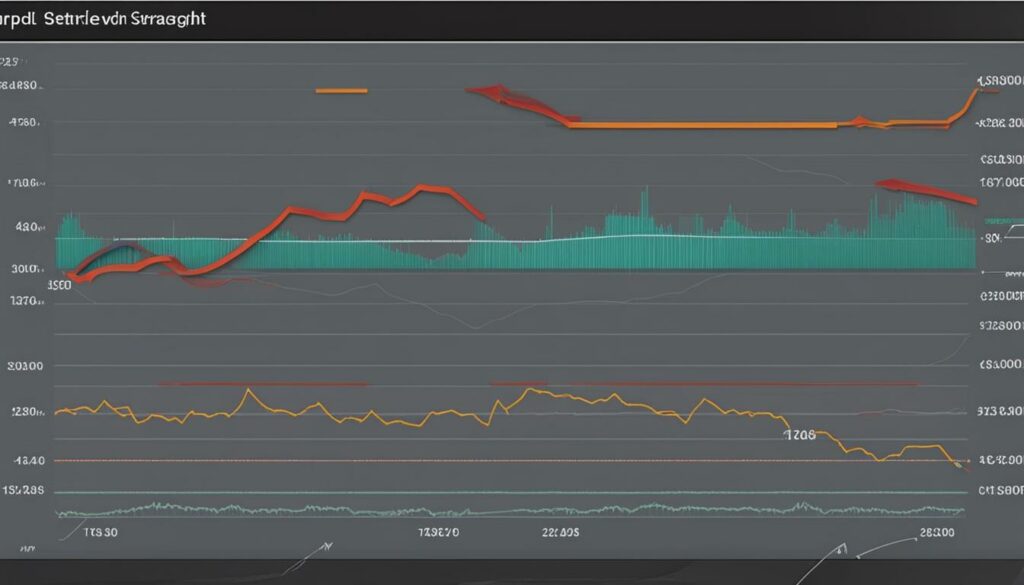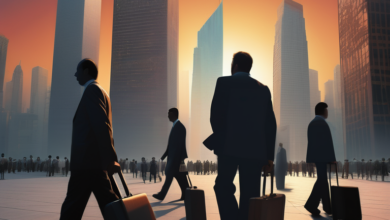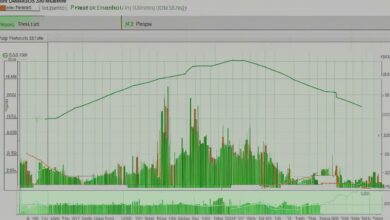Long Straddle Strategies: How And When To Use Them

A long straddle is an options trading strategy that involves purchasing both a long call and a long put on the same underlying asset with the same expiration date and strike price. Traders use this strategy to profit from a significant move in either direction by the underlying asset. It is especially popular ahead of important news events or when anticipating a rise in implied volatility. However, it is important to consider the risks involved, as the market may not react as expected.
Key Takeaways:
- A long straddle strategy involves purchasing a long call and a long put on the same underlying asset.
- Traders use long straddles to profit from significant moves in the underlying asset price or increased volatility.
- The strategy offers unlimited profit potential and does not require a directional bias.
- Risks include the cost of entering the strategy and the impact of time decay.
- Market conditions and risk tolerance should be carefully assessed before implementing a long straddle strategy.
Understanding Long Straddle
A long straddle is a popular option strategy that involves buying a long call and a long put on the same underlying asset, with the same strike price and expiration date. This strategy is used by traders who anticipate a substantial price movement in the underlying asset, regardless of the direction. It is often employed when there is an expectation of a shift from low volatility to high volatility, usually due to the release of important news or events.
The long straddle strategy aims to profit from a strong move triggered by a newsworthy event or a significant increase in market volatility. To maximize the chances of profiting from the anticipated move, the strike price is typically set at-the-money. This means that the strike price is approximately equal to the current price of the underlying asset, allowing the trader to cancel out small moves in either direction.
While the long straddle strategy offers the potential for significant profits, it is important to consider the associated risks. The market may not react as strongly as anticipated, resulting in the options expiring out of the money and rendering them worthless. Additionally, the increase in implied volatility may not lead to a significant rise in option prices, impacting the potential profitability of the strategy.

Table: Pros and Cons of Long Straddle
| Pros | Cons |
|---|---|
| Unlimited profit potential | Cost of entering the strategy |
| Market-neutral strategy | Potential decrease in option prices |
| Ability to profit from significant price movement | Time decay erodes option value |
Table: Pros and Cons of Long Straddle
“The long straddle strategy aims to profit from a strong move triggered by a newsworthy event or a significant increase in market volatility.”
Overall, understanding the long straddle option strategy is crucial for traders looking to capitalize on significant price movements and increased volatility. While it offers the potential for substantial profits, it is important to carefully consider the risks and manage them effectively. Traders should assess market conditions, select appropriate strike prices, and be mindful of the impact of time decay and the potential costs involved in entering and exiting the strategy.
Benefits of Long Straddle
The long straddle strategy offers several benefits to options traders. Its unique characteristics make it an attractive choice for those seeking profit potential while maintaining a market-neutral position.
Unlimited Profit Potential
One of the main advantages of a long straddle is the unlimited profit potential it offers. With this strategy, traders can profit from a significant move in the underlying asset’s price, regardless of the direction. Whether the price goes up or down, as long as it moves significantly, the trader stands to make a substantial profit.
Market-Neutral Position
Another benefit of the long straddle is its market-neutral position. Unlike other options strategies, the long straddle does not depend on the market’s overall direction. This makes it a versatile choice for traders who want to take advantage of specific events or volatility without having a bullish or bearish bias.
By initiating a long straddle, traders can profit from a significant move in either direction without having to predict which way the market will go. This flexibility can be particularly advantageous in uncertain market conditions or when there are upcoming news events.

The benefits of a long straddle strategy make it an attractive choice for options traders looking for profit potential and market neutrality. With its unlimited profit potential and the ability to profit from significant moves in either direction, the long straddle offers traders a versatile and potentially profitable options trading strategy.
Risks of Long Straddle
When implementing a long straddle strategy, it is crucial to be aware of the risks involved and to have a solid risk management plan in place. Here are the key risks to consider:
- The cost of entering the strategy: The long straddle requires purchasing both a long call and a long put option, which means paying the premiums for both contracts. These premiums can be significant, especially if the underlying asset has high volatility or if the expiration date is far in the future.
- Time decay: Options have a limited lifespan, and as time passes, the value of the options decreases. This is known as time decay. If the anticipated move in the underlying asset does not occur within the expected timeframe, the value of the options may erode, resulting in a loss for the trader.
It is important to closely monitor the progress of the underlying asset and the pricing of the options throughout the duration of the long straddle. Recognizing when to exit the position or adjust the strategy is crucial for managing risk and avoiding unnecessary losses.
In summary, the risks of a long straddle include the cost of entering the strategy and the potential impact of time decay on the value of the options. Traders should carefully assess their risk tolerance and continually evaluate market conditions to make informed decisions when implementing and managing a long straddle strategy.

Long Straddle Construction
The construction of a long straddle involves buying a long call and a long put on the same underlying asset with the same strike price and expiration date. This creates a long position that benefits from a significant move in either direction. The maximum risk in a long straddle is limited to the total cost of entering the position, which is the sum of the premiums paid for the options. The potential profit is unlimited on the upside if the asset price continues to increase, while the downside profit potential is limited by the strike price of the options.
By purchasing both a call and a put option, the trader has the right to buy or sell the underlying asset at the predetermined strike price. This strategy allows the trader to profit from a strong move in either direction, without having to predict the market’s overall direction. The long straddle is often used ahead of important news events or when there is an anticipation of increased volatility.
It is important to carefully consider the strike price and expiration date when constructing a long straddle. The strike price should be selected based on the trader’s expectations for the magnitude of the price move. If the strike price is set too high or too low, the options may not be profitable even if the underlying asset moves significantly. Additionally, the expiration date should align with the expected timeframe of the anticipated move to maximize the potential for profit.
| Pros | Cons |
|---|---|
| Unlimited profit potential on the upside | Premiums paid for options can be costly |
| Market-neutral strategy, not dependent on market direction | Options may expire worthless if there is no significant move |
| Can profit from increased volatility or important news events | Time decay can erode the value of options over time |
The table above summarizes the advantages and disadvantages of constructing a long straddle. Traders should carefully assess their risk tolerance and market conditions before implementing this strategy.
Alternative Use of Long Straddle
While the long straddle strategy is commonly used to profit from significant moves in the underlying asset price, some traders have discovered an alternative use for this options strategy. By initiating a long straddle position ahead of an anticipated event and closing it before the event occurs, traders aim to capture the expected rise in implied volatility.
Implied volatility is a crucial component in options pricing and represents the market’s expectations of future price fluctuations. When traders anticipate a significant event or news release, demand for options tends to increase, leading to higher implied volatility. By correctly predicting and timing the rise in implied volatility, traders can profit from the resulting increase in options prices.
This alternative use of the long straddle strategy focuses primarily on the implied volatility component rather than the underlying asset’s price movement. Traders must carefully analyze the market to identify events or catalysts that are likely to drive implied volatility higher. It is essential to note that this strategy relies on accurate timing and may not generate the same level of profits as a traditional long straddle that benefits from a strong move in the underlying asset’s price.
“The alternative use of the long straddle strategy allows traders to take advantage of the expected rise in implied volatility, providing an additional opportunity for profit in the options market.”
Example
| Event | Implied Volatility (IV) Before | Implied Volatility (IV) After | Long Straddle Profit Potential |
|---|---|---|---|
| Earnings Announcement | 20% | 40% | Potential for significant profit if the price move matches the increase in implied volatility |
| Drug Trial Results | 15% | 35% | Potential for significant profit if the price move matches the increase in implied volatility |
| Merger Announcement | 10% | 25% | Potential for moderate profit if the price move matches the increase in implied volatility |
Note: The profit potential of the long straddle strategy depends on various factors, including the accuracy of predicting the rise in implied volatility and the magnitude of the subsequent price move.

It is important to consider that the alternative use of the long straddle strategy is not suitable for every market situation. Traders should carefully assess the implied volatility levels, the timing of the expected event, and the potential impact on options pricing before implementing this strategy. Additionally, traders must account for the impact of time decay, as options prices may decline even if implied volatility increases.
Overall, the alternative use of the long straddle strategy provides traders with an additional opportunity to profit from the options market by targeting the expected rise in implied volatility. By accurately predicting and timing the increase in implied volatility, traders can potentially generate profits even in the absence of significant moves in the underlying asset’s price.
Long Straddle Market Outlook
When considering the market outlook for long straddles, it’s important to remember that this options trading strategy is market-neutral, meaning it doesn’t rely on the market’s overall direction. Instead, it seeks to profit from either a significant price change or increased volatility. Traders often use long straddles when they anticipate a big price move or high volatility in the near future.
A long straddle is suitable for situations where an investor expects an important event or news to significantly impact the underlying stock price. This strategy allows traders to position themselves for potential gains regardless of whether the price moves up or down. However, it’s crucial to note that a long straddle needs either a sustained move in one direction or increased volatility to be profitable.
Given its market-neutral nature, the long straddle strategy can be a valuable tool in a trader’s arsenal. By implementing a long straddle ahead of anticipated market-moving events, investors can aim to capture potential profits from significant price swings or heightened volatility. However, it’s essential to carefully assess market conditions and execute proper risk management strategies when utilizing the long straddle strategy.
Key Takeaways:
- A long straddle is a market-neutral strategy that seeks to profit from significant price changes or increased volatility.
- Traders often use long straddles when they anticipate a big price move or high volatility in the near future.
- This strategy allows investors to profit regardless of whether the price moves up or down, but it requires sustained movement or increased volatility to be profitable.
| Pros | Cons |
|---|---|
| Market-neutral strategy | Potential loss if the underlying asset does not experience a significant move or increased volatility |
| Opportunity for unlimited profit potential | Cost of entering the strategy, including premiums paid for options |
| Does not depend on the market’s overall direction | Time decay can erode option value |
Overall, the long straddle strategy can be a valuable tool for traders seeking to profit from market-moving events or increased volatility. However, it’s important to carefully assess market conditions, manage risk effectively, and understand that sustained movement or increased volatility is necessary for a long straddle to be profitable.

How to Set Up a Long Straddle
Setting up a long straddle involves buying a long call option and a long put option with the same strike price and expiration date. The options are typically purchased at-the-money, meaning the strike price is approximately equal to the current price of the underlying asset. Higher-priced assets will have more expensive premiums, and higher volatility leads to higher option prices. Traders can adjust the position above or below the stock price to create a bullish or bearish bias. The combined cost of the long call and long put determines the maximum risk, while the potential profit is unlimited beyond the initial debit.
When setting up a long straddle, it is important to carefully consider the strike price and expiration date. Choosing the at-the-money strike price allows for maximum flexibility, as small moves in either direction will not significantly impact the strategy. Additionally, selecting the appropriate expiration date is crucial, as it determines the amount of time available for the anticipated move or increase in volatility to occur.
Here is an example of how a long straddle could be set up:
| Long Call Option | Long Put Option |
|---|---|
| Strike Price: $50 | Strike Price: $50 |
| Expiration Date: July 31, 2022 | Expiration Date: July 31, 2022 |
In this example, both the long call and long put options have a strike price of $50 and an expiration date of July 31, 2022. This position benefits from a significant move in either direction, allowing the trader to profit if the stock price rises above $50 or falls below $50. The total cost of entering the long straddle position would be the sum of the premiums paid for both options.
Exiting and Rolling a Long Straddle
Exiting and rolling a long straddle strategy involves carefully timed actions to maximize profits or limit losses. Traders can choose to exit the position by selling the long call and long put options separately or roll the position to a later expiration date.
When the price of the underlying stock experiences a significant move in either direction or there is an increase in implied volatility, it may be an opportune time to exit the long straddle. Selling the long call and long put separately allows traders to capture gains from the options that have increased in value. It is generally more profitable to close the position before expiration, as time decay can erode the value of the options over time.
In situations where the desired move or volatility has not occurred, traders may choose to roll the long straddle to a later expiration date. Rolling the position involves closing the current options and opening new positions with a longer expiration date. However, it is important to note that rolling the position will incur additional costs, including the premiums for the new options, and extend the break-even points.
The decision to exit or roll a long straddle should be based on careful analysis of market conditions, including the expected duration of the anticipated move or volatility. Traders should also consider the impact of time decay and carefully weigh the potential costs and benefits of each option.
Hedging a Long Straddle
Hedging a long straddle can be a proactive approach to minimize risk and retain profits in the face of stock price movements. By adjusting the long put or long call options, investors can offset potential losses if the underlying stock moves sharply in one direction early in the expiration period. This hedging strategy helps protect against a reversal of the initial move and can be beneficial if the stock price retraces. It is an essential risk management technique that allows traders to navigate volatile market conditions while safeguarding their investment.
Implementing a hedge in a long straddle involves modifying the position to reduce potential losses. For example, if the underlying stock price experiences a significant increase, the trader can adjust the long put option by selling a portion or the entire position. This offsets any potential loss resulting from the increase in the stock price, allowing the trader to retain some profits. Similarly, if the stock price decreases, the trader can adjust the long call option by reducing the position or selling it entirely.
Hedging a long straddle requires careful consideration of the timing and magnitude of the stock price movement. Traders should closely monitor the market and assess whether the move is a temporary fluctuation or a sustained trend. By hedging strategically, traders can minimize losses in the event of an unfavorable stock price movement and optimize their profit potential.
| Advantages of Hedging a Long Straddle | Disadvantages of Hedging a Long Straddle |
|---|---|
|
|
Overall, hedging a long straddle is a risk management technique that allows traders to protect their investments in the face of stock price movements. By adjusting the long put and long call options strategically, traders can minimize potential losses and retain profits. However, it is essential to carefully consider the timing and magnitude of the stock price movement to optimize the effectiveness of the hedge. Traders should assess the advantages and disadvantages of hedging a long straddle and evaluate their risk tolerance before implementing this strategy.
Conclusion
In conclusion, the long straddle is a powerful options trading strategy that offers significant profit potential and effective risk management. By purchasing both a long call and a long put on the same underlying asset, traders can profit from substantial moves in the asset’s price or increased volatility.
One of the key advantages of the long straddle strategy is its market-neutral nature. It allows traders to benefit from specific events or volatility without having a bullish or bearish bias. This versatility makes it a popular choice among traders who seek to capitalize on significant market movements.
However, it is essential to carefully consider the risks associated with a long straddle strategy. Traders should be mindful of the cost of entering the strategy, including the premiums paid for the options. Additionally, the impact of time decay on option prices requires traders to monitor the position closely and consider closing it before expiration to avoid losing the entire premium investment.
To successfully implement a long straddle strategy, traders should assess market conditions, evaluate their risk tolerance, and have a clear exit strategy in place. By understanding the dynamics of the strategy and utilizing effective risk management techniques, traders can potentially maximize their profit potential while mitigating potential losses.
FAQ
What is a long straddle?
A long straddle is an options strategy that involves purchasing both a long call and a long put on the same underlying asset with the same expiration date and strike price.
When should I use a long straddle strategy?
Traders often use the long straddle strategy ahead of important news events or when they anticipate a rise in implied volatility.
What is the goal of a long straddle?
The goal of a long straddle is to profit from a significant move in either direction by the underlying asset.
What are the benefits of a long straddle?
The long straddle offers unlimited profit potential and is a market-neutral strategy, meaning it does not depend on the market’s overall direction.
What are the risks involved in a long straddle?
Risks in a long straddle strategy include the cost of entering the strategy, the potential for options to expire worthless, and the impact of time decay on option values.
How do I construct a long straddle?
To construct a long straddle, you buy a long call and a long put on the same underlying asset with the same strike price and expiration date.
Can a long straddle be used for capturing rising implied volatility?
Yes, some traders use the long straddle strategy to profit from increasing implied volatility.
Is the long straddle a market-neutral strategy?
Yes, the long straddle is a market-neutral strategy that does not require a bullish or bearish bias.
How do I exit or roll a long straddle?
The long straddle can be exited by selling-to-close the options or rolled to a later expiration if the desired move or volatility has not occurred.
How can I hedge a long straddle?
Hedging a long straddle involves adjusting the options to offset potential losses if the underlying stock moves sharply in one direction.







